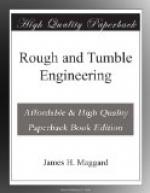Should the plug melt out, it is necessary to replace it at once, or as soon as the heat will permit you to do so. It might be a saving of time to have an extra plug always ready, then all you have to do is to remove the melted one by unscrewing it from the crown sheet and screwing the extra one in. But if you have no extra plug you must remove the first one and refill it with babbitt. You can do this by filling one end of the plug with wet clay and pouring the metal into the other end, and then pounding it down smooth to prevent any leaking. This done, you can screw the plug back into its place.
If you should have two plugs, as soon as you have melted out one replace it with the new one, and refill the other at your earliest convenience. By the time you have replaced a fusible plug a few times in a hot boiler you will conclude it is better to keep water over your crown sheet.
LEAKY FLUES
What makes flues leak? I asked this question once, and the answer was that the flues were not large enough to fill up the hole in flue sheet. This struck me as being funny at first, but on second thought I concluded it was about correct. Flues may leak from several causes, but usually it can be traced to the carelessness of some one. You may have noticed before this that I am inclined to blame a great many things to carelessness. Well, by the time you have run an engine a year or two you will conclude that I am not unjust in my suspicions. I do not blame engineers for everything, but I do say that they are responsible for a great many things which they endeavor to shift on to the manufacturer. If the flues in a new boiler leak, it is evident that they were slighted by the boiler-maker; but should they run a season or part of a season before leaking, then it would indicate that the boiler-maker did his duty, but the engineer did not do his. He has been building too hot a fire to begin with, or has,




